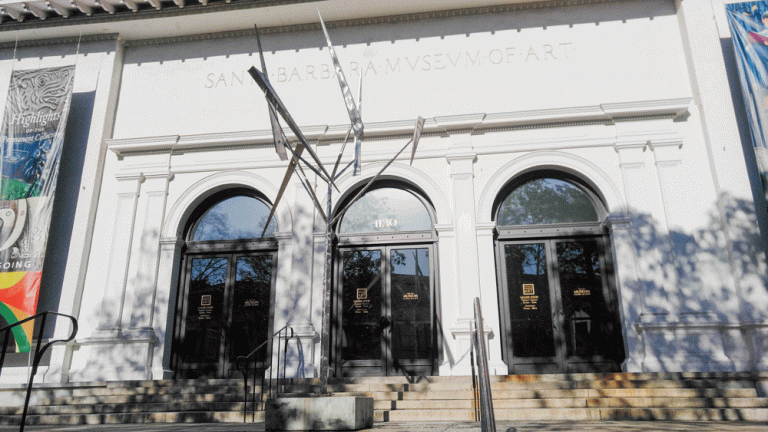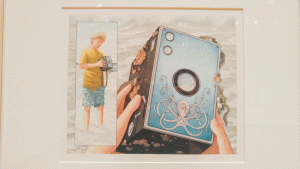
Jack Shea
A long weekend coming and unpredictable weather call for a quick trip to the Santa Barbara Museum of Art. Though grand in size and taller than the fine restaurants beside it on State Street, the current exhibits only take an hour or two to completely explore, though they stun with permanent and visiting collections.
After walking up dazzling white steps and into easing soft light, the Santa Barbara Museum of Art welcomes guests with Judith Shea’s “Mid-Life Venus.” To the viewer, she may just be a depiction of the modern struggles of aging women, but there is possibly more. Shea’s work invites query of the transition between the understanding of the body, the recognition of the time’s understanding of it, and how this blends into her modern work. Such query sojourns as the exhibits transition from the beginning to the end.
The museum also features three-time Caldecott Medal winner David Wiesner’s watercolors, which portray stories about life through fantasy. The museum will display some of Wiesner’s watercolors until early May, and visitors are in for a visual journey when viewing his works. Wiesner’s works dance across art movements, but they each are masterfully designed into complex depictions of transient locales, such as in his work “Flotsam.”
Inspired by surrealist works, Wiesner’s “Flotsam” paints an unsuspecting boy’s discovery of worldly awareness through an old camera washed up on the beach. The camera presents a temporal and special paradigm of history, from previous users, to the boy’s awareness, which is captured as the boy sees the experiences of children before them and records his. Sharing such with the world, he catapults the camera back into the ocean. The camera continues an adventure of oceanic and worldly documentation.

Not only is Wiesner’s exhibit sharing the complex watercolors, behind his famous works, pictured into transitory children’s book pages, but the works of his time studying at Rhode Island School of Design are also shown. On display lies his famous work blending King Kong and Leonardo Da Vinci’s Vitruvian Man, his senior thesis. In this work, visitors see firsthand the artistic risks Wiesner took as a young man to explore his talent as a period and ideology-blending artist. In his watercolors, Wiesner has no fear blending art movements and aspirations, of different times, to portray one image, which is part of why his work appeals to all ages.
“The value of this picture book can be read by many people … kids, adults … it’s just beyond what books can do,” said Fang He, a Ph.D. student in history at the University of California, Santa Barbara. “Those pictures, without words, give you a lot of space for imagination in what kind of story the author [or the viewer] wants to tell.”
The same can be said for videography at the museum.
On the way to Wiesner’s works, visitors can stop by Christian Marclay’s “Telephones” exhibit. Examining “the pre-smart phone era,” Marclay invites visitors to take a back seat examining the roles phones play in the human experience. Elegantly showcasing works from Hollywood’s Golden Era to the anxious rush of latter-day rom-coms, Marclay displays the relationship between humans and their phones.
Though they had no applications or anything exciting to show relative to smartphone standards, the phones play pivotal roles in cinema altering human perspective, experience, and timing. Phones remove limits on cinematic time, scenes, and organization. Ironically, they impact humans continually to be observed through recording on recording, as displayed in Marclay’s work.
Original works by Monet, Delacroix, and other timeless pastels continuously rejuvenate the “Permanent Collection” visitor experiences at Santa Barbara Museum of Art. The display reminds visitors why museums are continually relevant to the educational and community impacts by displaying moving works to inspire viewers.
For example, some permanent display work is from Chinese spiritual and religious artists from various time periods. Timeless works, such as the “Zun-Shaped Vase” from the Qing dynasty, highlight longevity in art wishing viewers a peaceful life in its eternal spring depiction.
More from the permanent collection includes Jean Baptiste Camille Corot’s “Pleasures of the Evening,” which captures the viewer’s eye with seductive “nostalgia,” as described in in the museum’s description. The warmth of the golden beige relaxes the eye, gazing at dancing trees and vivacious musicians in the sunset. This work of art alone is worth a trip downtown.
Student admission is free; therefore, UCSB students can take advantage of the upcoming long weekend with a relaxing, educational experience at the Santa Barbara Museum of Art.
The Santa Barbara Museum of Art is located at 1130 State St., Santa Barbara, Calif. 93101. SBMA is open from 11:00 a.m. to 5:00 p.m. everyday except Monday.
















